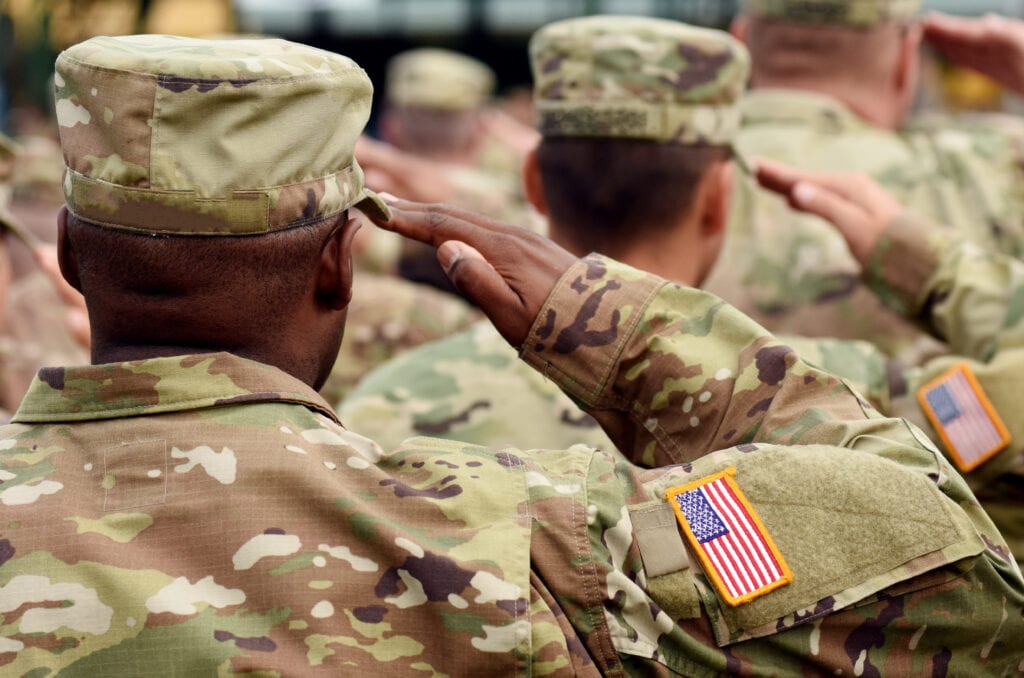Looking for Expert-Level VA Claim Answers?📱Call Us Now! 737-295-2226
If you’ve ever wondered “What is a Veteran” stay tuned because this high-value blog post is for you.
I will also reveal and explain the official Veteran Definition, as codified in federal law, to include new tips for determining veteran status for VA benefits.
Table of Contents
What is a Veteran?

Veteran Definition
38 U.S. Code § 101 defines a military veteran as: (1) A person who served in the active military, naval or air service, and (2) Was discharged or released under conditions other than dishonorable.
Both criteria above must be satisfied to meet the official veteran definition.
What is the “Active Military, Naval, or Air Service?”
The term “active military, naval, or air service” includes:
(A) Active duty;
(B) Any period of active duty for training during which the individual concerned was disabled or died from a disease or injury incurred or aggravated in line of duty; and
(C) Any period of inactive duty training during which the individual concerned was disabled or died—
(i) from an injury incurred or aggravated in line of duty; or
(ii) from an acute myocardial infarction, a cardiac arrest, or a cerebrovascular accident occurring during such training.
Source: See 38 U.S. Code § 101 – Definitions for a complete list of terms.
Deserve a HIGHER VA Rating? WE CAN HELP.
Join our premier education-based membership program, VA Claims Insider Elite, connect with an expert-level Veteran Coach (VC) within minutes, and finally get the rating you deserve. Click the button below to get started.
What is the legal definition of “Active Duty?”

The term “active duty” means:
(A) Full-time duty in the Armed Forces, other than active duty for training;
(B) Full-time duty (other than for training purposes) as a commissioned officer of the Regular or Reserve Corps [1] of the Public Health Service (i) on or after July 29, 1945, or (ii) before that date under circumstances affording entitlement to “full military benefits” or (iii) at any time, for the purposes of chapter 13 of this title;
(C) Full-time duty as a commissioned officer in the commissioned officer corps of the National Oceanic and Atmospheric Administration or its predecessor organization the Coast and Geodetic Survey (i) on or after July 29, 1945, or (ii) before that date (I) while on transfer to one of the Armed Forces, or (II) while, in time of war or national emergency declared by the President, assigned to duty on a project for one of the Armed Forces in an area determined by the Secretary of Defense to be of immediate military hazard, or (III) in the Philippine Islands on December 7, 1941, and continuously in such islands thereafter, or (iii) at any time, for the purposes of chapter 13 of this title;
(D) Service as a cadet at the United States Military, Air Force, or Coast Guard Academy, or as a midshipman at the United States Naval Academy; and
(E) Authorized travel to or from such duty or service.
How does the VA define “Active Duty for Training (ADT)?”
The term “active duty for training” means:
(A) Full-time duty in the Armed Forces performed by Reserves for training purposes;
(B) Full-time duty for training purposes performed as a commissioned officer of the Reserve Corps of the Public Health Service (i) on or after July 29, 1945, or (ii) before that date under circumstances affording entitlement to “full military benefits”, or (iii) at any time, for the purposes of chapter 13 of this title;
(C) In the case of members of the Army National Guard or Air National Guard of any State, full-time duty under section 316, 502, 503, 504, or 505 of title 32, or the prior corresponding provisions of law;
(D) Duty performed by a member of a Senior Reserve Officers’ Training Corps program when ordered to such duty for the purpose of training or a practice cruise under chapter 103 of title 10 for a period of not less than four weeks and which must be completed by the member before the member is commissioned; and
(E) Authorized travel to or from such duty.
The term “Active Duty for Training” does not include duty performed as a temporary member of the Coast Guard Reserve.
How does the VA define “Inactive Duty for Training (IADT)?”
The term “inactive duty training” means:
(A) Duty (other than full-time duty) prescribed for Reserves (including commissioned officers of the Reserve Corps 1 of the Public Health Service) by the Secretary concerned under section 206 of title 37 or any other provision of law;
(B) Special additional duties authorized for Reserves (including commissioned officers of the Reserve Corps of the Public Health Service) by an authority designated by the Secretary concerned and performed by them on a voluntary basis in connection with the prescribed training or maintenance activities of the units to which they are assigned; and
(C) Training (other than active duty for training) by a member of, or applicant for membership (as defined in section 8140(g) of title 5) in, the Senior Reserve Officers’ Training Corps prescribed under chapter 103 of title 10.
In the case of a member of the Army National Guard or Air National Guard of any State, such term means duty (other than full-time duty) under sections 316, 502, 503, 504, or 505 of title 32, or the prior corresponding provisions of law. Such term does not include (i) work or study performed in connection with correspondence courses, (ii) attendance at an educational institution in an inactive status, or (iii) duty performed as a temporary member of the Coast Guard Reserve.
What is a Protected Veteran?

A Protected Veteran is defined by the Vietnam Era Veterans’ Readjustment Assistance Act of 1974 (VEVRAA), as amended (38 U.S.C. § 4212), which prohibits discrimination against protected veterans.
Under VEVRAA, a veteran may be classified as a ‘‘disabled veteran,’’ ‘‘recently separated veteran,’’ ‘‘active-duty wartime or campaign badge veteran,’’ or ‘‘Armed Forces service medal veteran.’’
The four categories listed below have “Protected Veteran” status.
#1. Disabled Veteran
(1) Are you a veteran of the U.S. Military who is entitled to compensation (or who but for the receipt of military retired pay would be entitled to compensation) under laws administered by the Secretary of Veterans Affairs? Or
(2) Were you discharged or released from active duty because of a service-connected disability?
If you answered “yes” to either of these questions, you are a Disabled Veteran with protected status.
#2. Recently Separated Veteran
Were you discharged or released from active duty within the last three years?
If you answered “yes” to this question, you are a Recently Separated Veteran with protected status.
#3. Active Duty Wartime or Campaign Badge Veteran
(1) Did you serve on active duty during one or more of the periods of war outlined in 38 U.S.C. § 101?
(2) Did you serve on active duty in any campaign or expedition for which a campaign badge has been authorized under the laws administered by the Department of Defense?
If you answered “yes” to question #1, you are an active-duty wartime veteran with protected status.
If you answered “yes” to question #2, you are a campaign badge veteran with protected status.
#4. Armed Forces Service Medal Veteran
(1) Did you serve on active duty in a U.S. military operation for which an Armed Forces Service Medal was awarded pursuant to Executive Order 12985 (61 FR 1209) and were you awarded the Armed Forces Service Medal?
(2) If you were awarded the Armed Forces Service Medal, is it listed on your DD Form 214?
If you answered “yes” to either of these questions, you are an Armed Forces Service Medal Veteran with protected status.
What is considered “Qualifying Service” for VA benefits?

Qualifying Service is any type of service that qualifies or potentially qualifies a veteran for VA benefits.
Types of qualifying service are listed in 38 CFR 3.6 and 38 CFR 3.7 and include (but are not limited to):
- Active service
- Active Duty for Training (ADT) when a claim for service connection (SC) is based on a disability or death resulting from a disease or injury incurred or aggravated in the line of duty, and
- Inactive Duty for Training (IADT) when a claim for SC is based on disability or death resulting from an injury incurred or aggravated in the line of duty or myocardial infarction, cardiac arrest, or a cerebrovascular accident which occurred during such training.
How Does the VA Determine Line of Duty Status for Claims Based on Active Duty for Training or Inactive Duty for Training?
Formal line-of-duty investigations should be documented on DD Form 261. However, not all injuries, diseases, or deaths incurred or aggravated in the line of duty will be documented on DD Form 261, and a formal line-of-duty investigation is not a requirement to establish that a disease, injury, or death was incurred or aggravated in the line of duty during a period of ADT or IADT.
Consider all evidence of record in determining whether the injury, disease, or death was incurred or aggravated in the line of duty.
Special Note: “In the line of duty” does not always mean while the reservist or National Guard member was at work. Individuals with AGR service, including in the National Guard, are on continuous duty 24 hours a day, seven days a week just as are their active duty counterparts. They receive the same pay and are eligible for retirement with 20 years of service. If no intentional negligence or willful misconduct is noted, an injury or disease that occurs during AGR service is presumed to be in the line of duty.
References: For more information on,
- Duty status related to injuries sustained by reservists or National Guard members while traveling to or from periods of ADT or IADT, see 38 CFR 3.6(e), and
- Determining line-of-duty status, see Holton v. Shinseki
Are you STUCK, FRUSTRATED and UNDERRATED?
You are not alone! We are Veterans helping Veterans!
Become an Elite Member and work with our Veteran Coaches to get the rating you deserve!

Brian Reese
Brian Reese is a world-renowned VA disability benefits expert and the #1 bestselling author of VA Claim Secrets and You Deserve It. Motivated by his own frustration with the VA claim process, Brian founded VA Claims Insider to help disabled veterans secure their VA disability compensation faster, regardless of their past struggles with the VA. Since 2013, he has positively impacted the lives of over 10 million military, veterans, and their families.
A former active-duty Air Force officer, Brian has extensive experience leading diverse teams in challenging international environments, including a combat tour in Afghanistan in 2011 supporting Operation ENDURING FREEDOM.
Brian is a Distinguished Graduate of Management from the United States Air Force Academy and earned his MBA from Oklahoma State University’s Spears School of Business, where he was a National Honor Scholar, ranking in the top 1% of his class.



